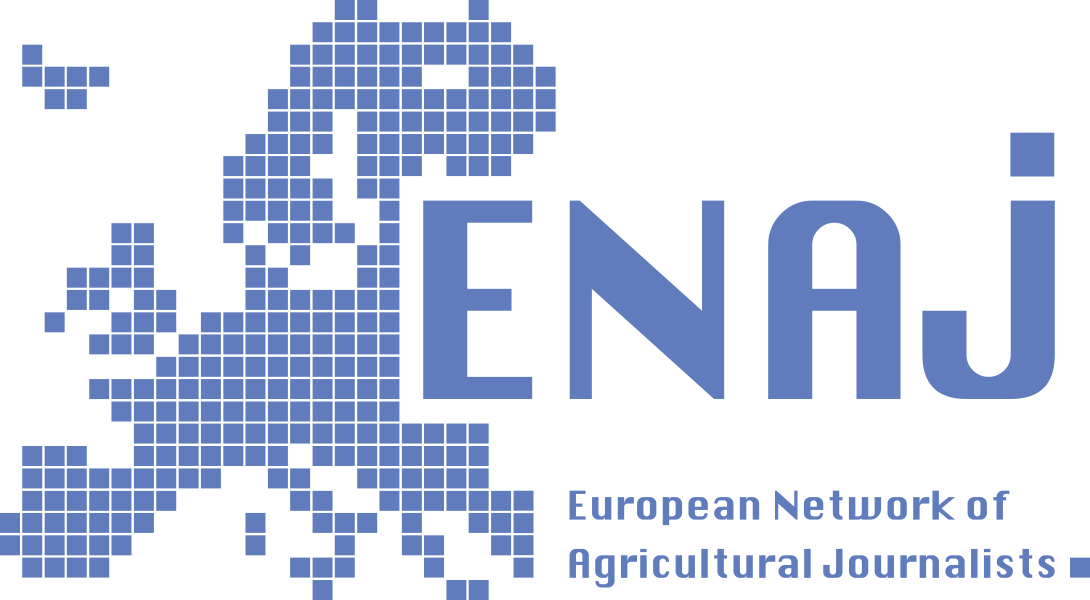ENAJ and EU-FarmBook organized a three-days-presstrip to Bonn, Germany, on the topic of innovation transfer and innovative farms.
The press trip took place in Bonn from 22 to 24 September. It was the second press trip, which has been organized by ENAJ in cooperation with the EU-funded project EU-FarmBook and again agricultural journalists from all EU countries were invited. The three-day programme kicked off with a panel discussion and an exhibition of spin-offs and start-ups at the University of Bonn. On the following two days, the journalists visited the Klein-Altendorf outdoor laboratory and four farms that have set themselves up for the future with innovative ideas.
The central panel discussion at the Poppelsdorf Campus of the University of Bonn focussed on the transfer of innovation and the upcoming launch of the digital platform EU-FarmBook. Representatives from science, business, project funding and agricultural journalism discussed how farmers can best be informed about new scientific findings and project results.

The EU-FarmBook platform’s potential for innovation transfer was the subject of lively discussion. From left to right: Aneta Suchon from Poland, Leonie Göbel, Consultant for EIP-Agri and AKIS in Germany, Heiner Kuhlmann, Spokesperson Phenorob, Moderator Katharina Seuser, Pieter Spanoghe, Coordinator EU-FarmBook, Yanne Boloh, chairwoman ENAJ, Peter Dissenbacher, WeGrow Group. Photo: EU-FarmBook/ Jonathan Schmitt
Pieter Spanoghe, professor at the University of Ghent and coordinator of EU-FarmBook, emphasised the importance of innovation transfer: “Billions are invested in agricultural research in the EU. Without robust mechanisms to transfer the results into practice, much of this knowledge remains inaccessible to those who could benefit from it. This jeopardises the impact that research is supposed to achieve.”
Yanne Boloh, ENAJ Chair, journalist and director of the French press agency Phileas Info, represented the EU agricultural journalists in the panel discussion. She reported on innovation reporting in France. Innovation is considered very important there, which is why the French Association of Agricultural Journalists AFJA has been awarding the ‘Graine d’innovation’ (Seed of Innovation) prize every year since 2018, a prize that recognises reporting on forward-looking and innovative topics in the fields of agriculture, the environment, food and rural life. Yanne Boloh believes that innovation opens up opportunities, but also raises questions. And this is where agricultural journalists come in to connect, translate and communicate these complex issues with clarity, fairness and empathy. Yanne Boloh sees great potential in the EU FarmBook platform as it could provide journalists with a source of good stories for farmers. However, EU-FarmBook will not replace journalists, she said.
The EU FarmBook digital platform is set to become a central instrument for the transfer of innovation. The launch is planned for the end of the year, Pieter Spanoghe informed. Project organisers from all over the EU are currently uploading practical information, which can then be accessed in all EU languages. Pieter Spanoghe said: ‘EU-FarmBook is more than just a digital archive – it is becoming a reference point for farmers, foresters and advisors looking for practical, research-based solutions.’ The results will be available in all EU languages and users will have access to an AI-supported chatbot for their queries, which can already be tested.
There was great interest in the EU FarmBook platform, but there was also scepticism. It was important that the platform could be tested as soon as possible. For Peter Dissenbacher, founder of the spin-off Wegreen, it is important for success that the innovations on EU-FarmBook are successful in practice. Prof. Dr. Heiner Kuhlmann, spokesperson of the Phenorob Cluster of Excellence, emphasised that a lot of communication was needed to make EU-FarmBook known and successful. However, great efforts are always a prerequisite for success, as the story of the Wegreen spin-off showed.
Accompanying the panel discussion, 16 spin-offs and research projects presented themselves at an ideas market in the foyer of the lecture centre on the Poppelsdorf Campus. The spin-offs of the University of Bonn were prominently represented with WeGrow and spin-offs from the Phenorob Cluster of Excellence. VisioChick, a current research project at the university, was also presented. VisioChick is developing smart glasses that improve the understanding of animal welfare, focussing on visual aspects. Garrulus, a spin-off from Bonn-Rhein-Sieg University of Applied Sciences, presented a drone that can be used for reforestation.

Marketplace of ideas: Peter Dissenbacher, co-founder of WeGrow, presented the very fast-growing cherry tree (also known as Palownia) and the sustainable timber construction modules made from it at his stand. Photo: EU-FarmBook/ Jonathan Schmitt

Marketplace of ideas: The GARRULUS research project is working on the development of a drone that autonomously sows trees and can therefore be used for reforestation. Research assistant Ahmad Drak explained the innovation to inquisitive participants.
Photo: EU-FarmBook/ Jonathan Schmitt

Marketplace of ideas: Artificial intelligence (AI) has arrived in the agricultural sector. Dr Josef Franko from AI.Land used a Lego model of a solar-powered field robot to show how AI can be used for more efficient crop protection.
Photo: EU-FarmBook/ Jonathan Schmitt
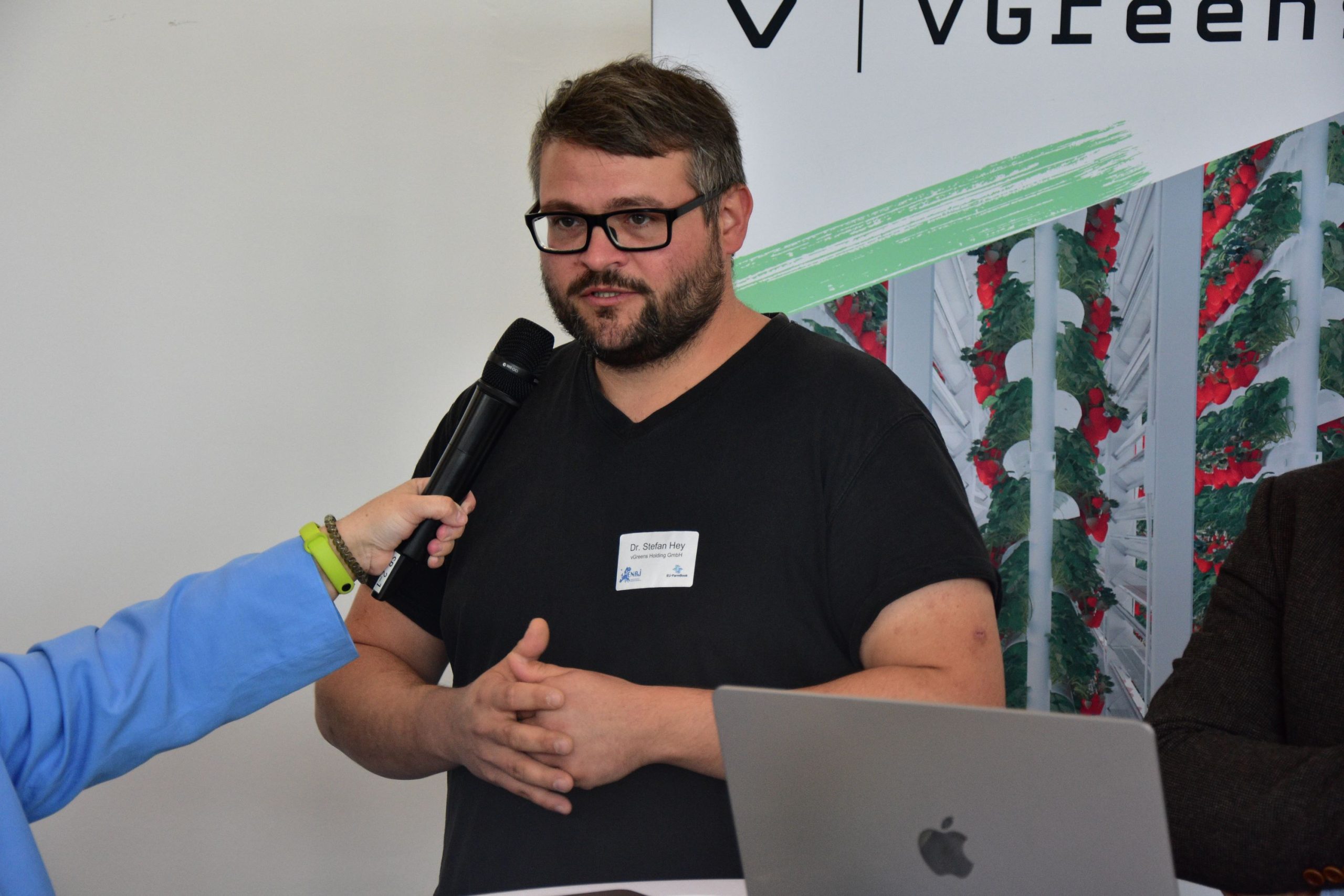
Marketplace of ideas: According to the spin-off vGreens, our future food supply will come from vertical greenhouses. Co-founder Dr Stefan Hey is focusing on collecting data that provides information on the most important growth parameters of plants.
Photo: EU-FarmBook/ Jonathan Schmitt
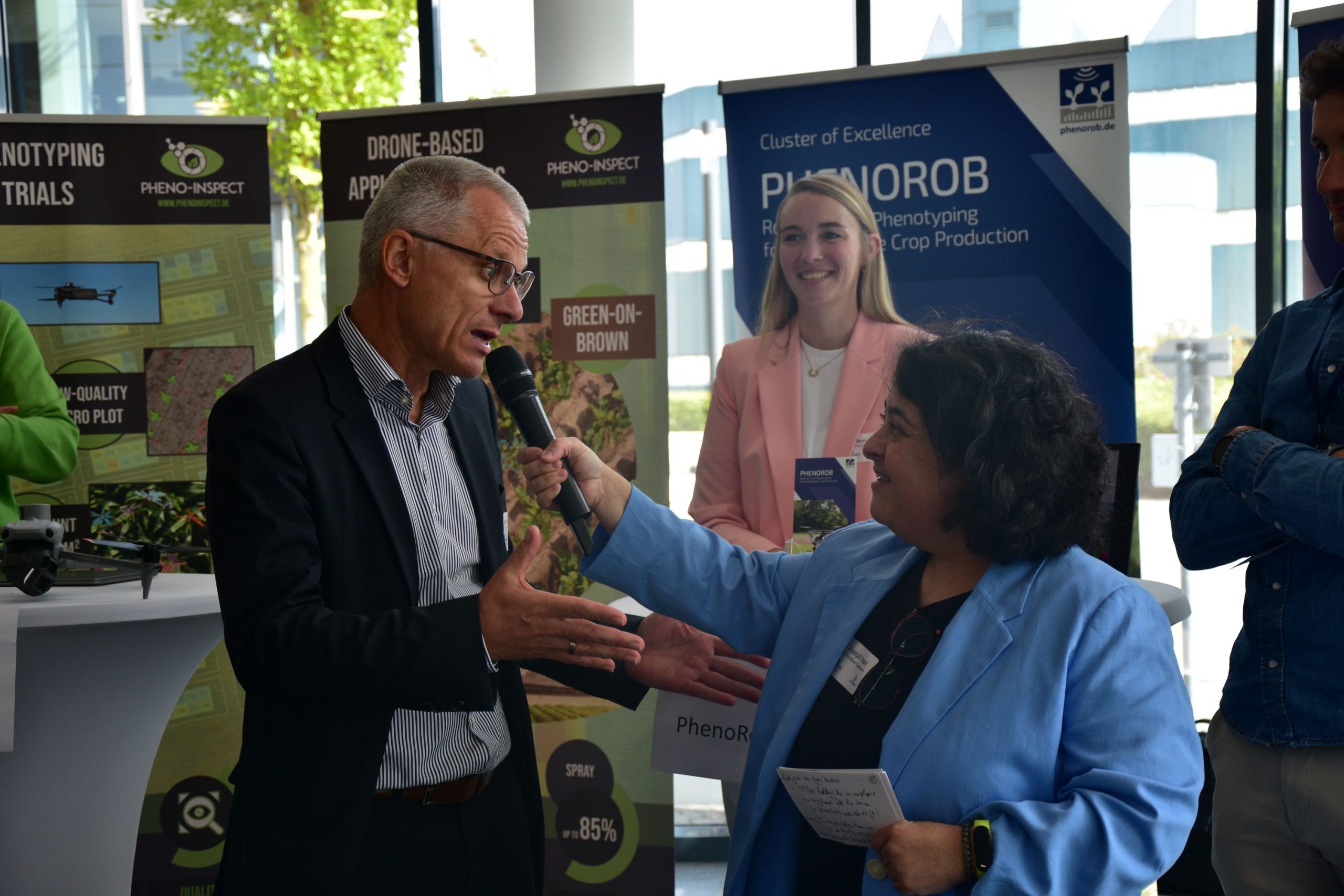
Marketplace of ideas:
Prof Dr Heiner Kuhlmann, Head of the Geodesy Group at the Institute of Geodesy and Geoinformation IGG at the University of Bonn and spokesperson for the Phenorob Cluster of Excellence, presented cutting-edge research: PhenoRob stands for interdisciplinary research in robotics and phenotyping of crops. Robots are being developed that can be used autonomously for care and plant protection measures in agriculture and horticulture by recognising plants.
Photo: EU-FarmBook/ Jonathan Schmitt
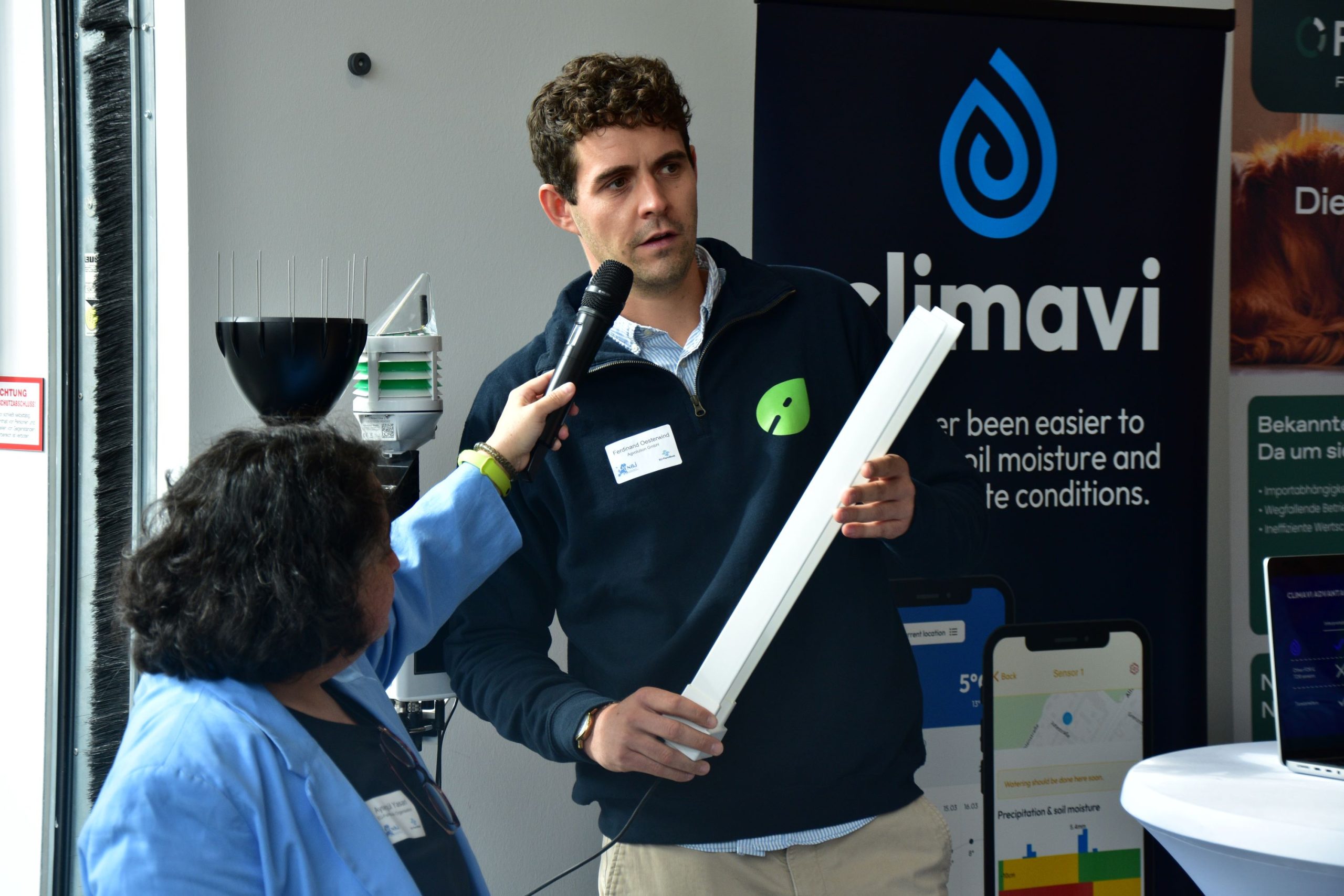
Marketplace of ideas: The company Agvolution, represented by employee Ferdinand Oesterwind, presented innovative soil moisture measuring sensors.
Photo: EU-FarmBook/ Jonathan Schmitt
The following day, the journalists visited the Klein-Altendorf Satellite Campus. This is where research on plant cultivation topics takes place under practical conditions. Current research projects include the cascade utilisation of Miscanthus, an arable crop that can prevent erosion and flooding in flood-prone areas and can be used in a variety of ways as a renewable raw material. In horticulture, Miscanthus has proven its worth as a planting substrate in greenhouses and as bedding for horses. After this utilisation, lignin recovery as a raw material for the chemical industry would be conceivable, followed by use as a fertiliser or in thermal utilisation.
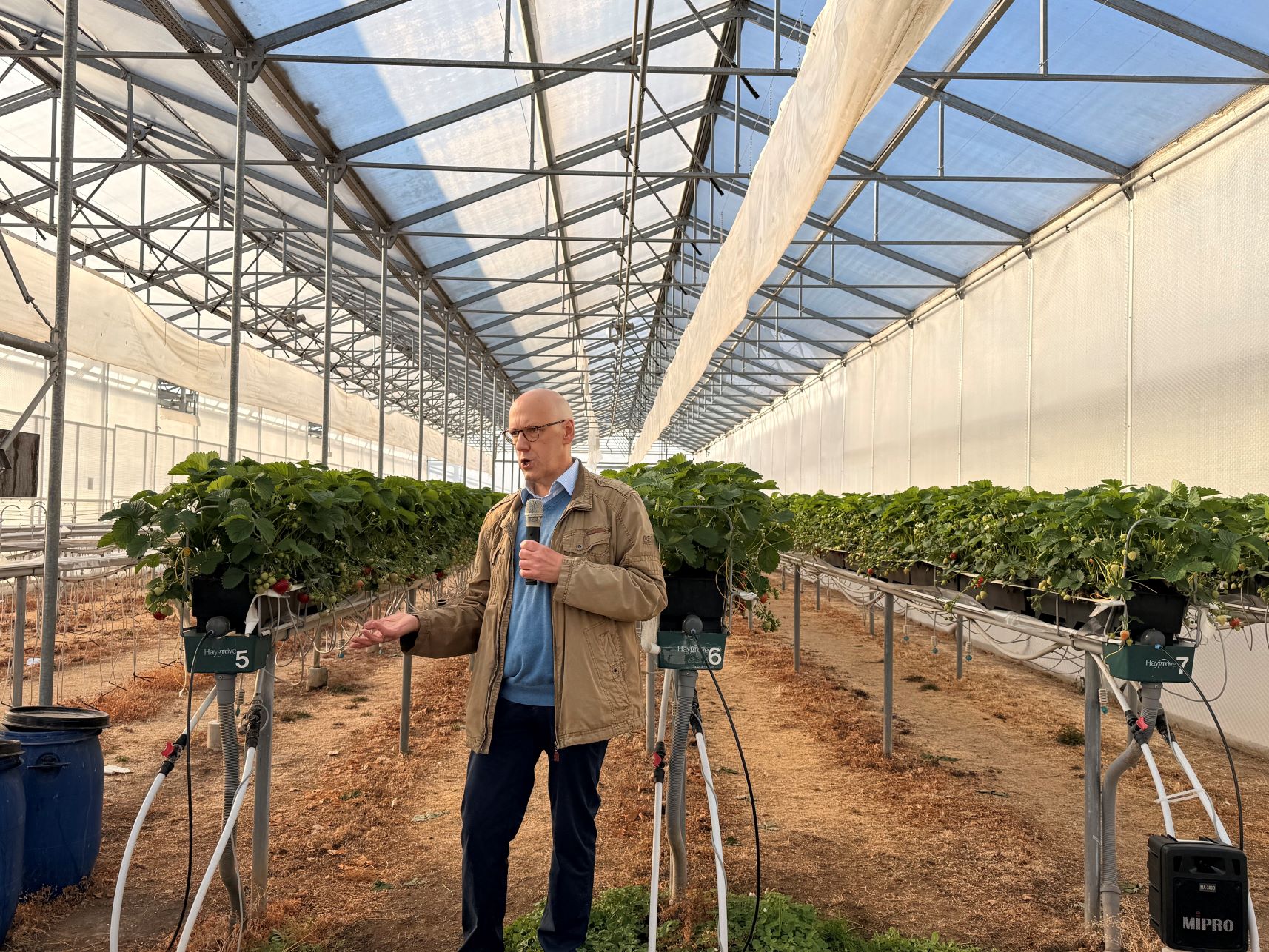
At the Klein-Altendorf Campus of the University of Bonn, Thorsten Kraska presented research into Miscanthus as a planting substrate for growing strawberries.
Photo: EU-FarmBook/ Aysegül Yasari
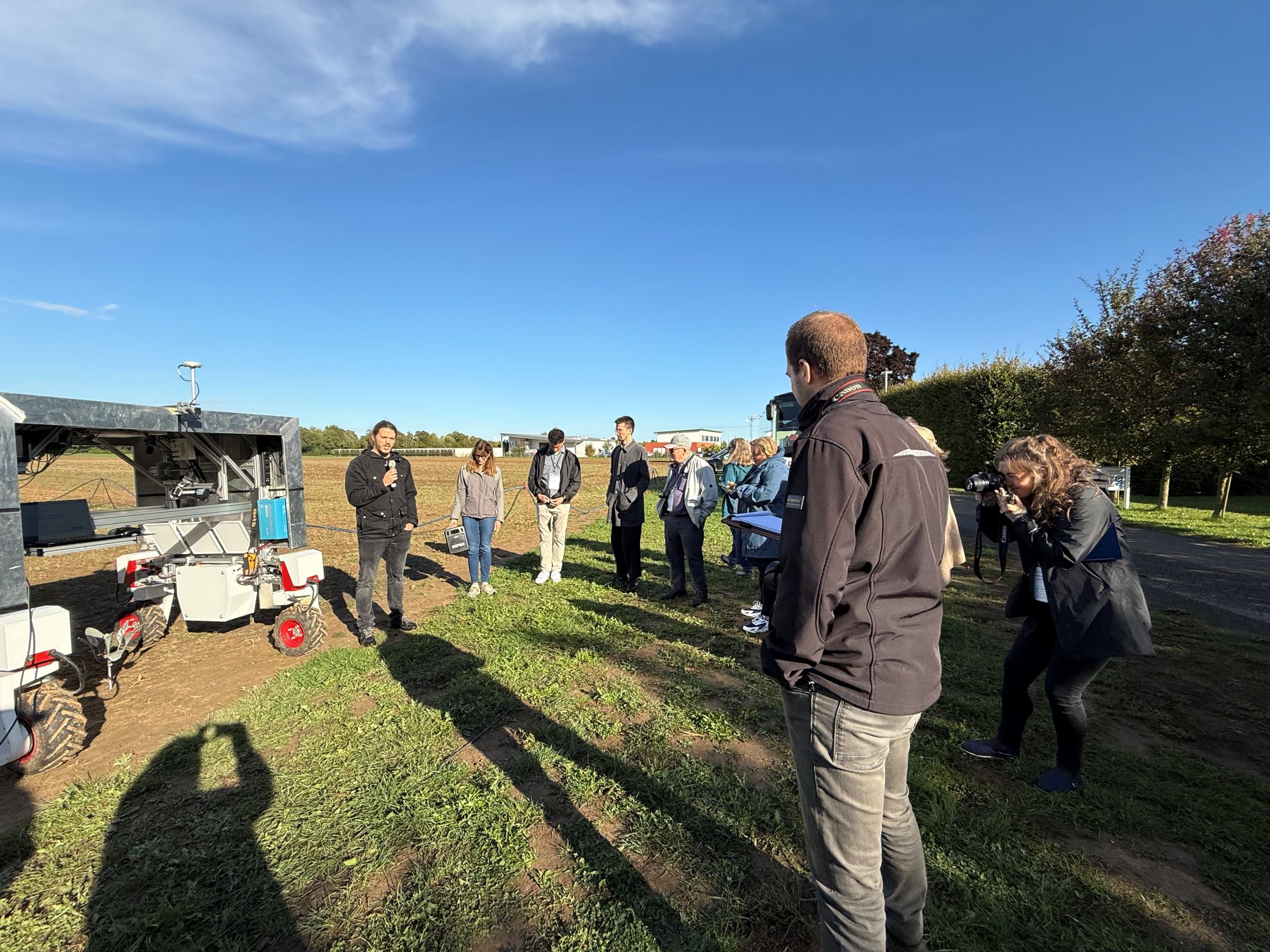
The journalists showed great interest in a field robot that uses sensors and cameras to generate a 3D model of the plants. This makes it possible to recognise whether the plant has diseases or is infested by pests. This robot is currently being further developed by Phenorob research at the Institute of Geodesy and Geoinformation at the University of Bonn. Photo: EU-FarmBook/ Aysegül Yasari
Gerd Möhren, a farmer from Bengen, confirmed that cultivation of Miscanthus can be successful under practical conditions. Many of his arable fields are located on a slope and valuable arable soil is washed down into the valley during heavy rainfall. For this reason, he began growing Miscanthus across the slope back in 2011. Since then, the permanent crop has not only protected against erosion, but is also financially worthwhile. He sells the shredded crop as bedding for horse owners. An example of a new crop that both protects against heavy rainfall and contributes to a secure income.

Gerd Möhren, a farmer from Bengen (Rhineland-Palatinate), proudly showed off the field where he has been growing miscanthus since 2011. It protects his farm from flooding and he currently earns more from miscanthus than from growing wheat. Behind this is his own marketing concept for miscanthus litter to horse owners, a self-built customer base and a stake in a logistics company.
Photo: EU-FarmBook/ Aysegül Yasari
Fruit growing dominates in nearby Gelsdorf, where Johannes and Christian Nachtwey operate an organic fruit farm. They are specialised on apple and pear production, combining organic production with modern quality standards. They operate a test Agri-PV system for climate-friendly fruit growing on his farm together with the Fraunhofer Research Institute. The impact of the system on apple cultivation is now being recorded over several years. Although the test results are not yet available, Christian Nachtwey is already certain that the system has a positive influence on apple production. On the one hand, the solar panels protect against extreme weather conditions such as hail and the increasingly strong sun, and on the other hand, the panels create a favorable microclimate and the amount of fungizides can be reduced. The system replaces the hail nets required in the region, but of course the investment for an Agri-PV system is very large.
The apple harvest was in full swing and the journalists enjoyed a few juicy apples from the Nachtweys’ orchard, ready for harvesting.

This agrivoltaic system is located in an apple orchard on the Nachtweys’ fruit farm in Grafschaft (Rhineland-Palatinate). Christian Nachtwey emphasised the advantages of the photovoltaic system above his apple trees. The system is being operated for a research project together with the Fraunhofer Institute on a test area of around 9,100 square metres. The PV system can generate up to 258 kWh.
Photo: EU-FarmBook/ Aysegül Yasari

House made of wood from the palownia tree and miscanthus grass. Sensors are installed in the building to investigate the insulating properties of these two materials. Photo: EU-FarmBook/ Aysegül Yasari

Percy-Bodo von Oheimb-Loup, Friederike tho Seeth and Thomas Beyel (from left to right) of the University of Bonn and the Bio Innovation Park Rhineland showed the journalists a small house made of palownia and miscanthus. The Bio Innovation Park Rhineland is researching these materials with the aim of investigating whether CO2-neutral construction is possible in the future.
Photo: EU-FarmBook/ Aysegül Yasari
On the third day the journalists visited the dairy farm “Schöpcher Hof” of Christoph Lüpschen and the farm of family Trimborn, who have specialized on regional products, self marketing and tourism. Both farms are located in the hilly region “Bergisches Land”. Christoph Lüpschen is a real innovator: Since taking over the farm, he has always been the first in the region to try out new technologies – from milking robots and biogas to exporting livestock all over the world. For some years now, his farm has been supplying a nearby industrial estate with electricity and district heating. His motto is to improve the added value of traditional milk production. His wife and his three children work on the farm.

The farmer Dr Christoph Lüpschen in an interview. The Schöpcherhof dairy farm near Lohmar in the Bergisches Land region has been owned by the Lüpschen family for seven generations.
Photo: EU-FarmBook/ Aysegül Yasari
The family farm Trimborn “Bauerngut Schiefelbusch” is run by the parents Helga and Albert and their son Andreas run the farm. The Trimborns focuss on regional products, direct marketing and tourism 40 years ago: The farm is open 24/7 to hikers, cyclists, schools and holidaymakers. From the farm shop you can see into the cowshed, from the café into the chicken run and when journalists visited Gut Schiefelbusch, 1500 geese grazed next to the farm. Son Andreas works on the farm, son Simon and the two daughters support the business with good ideas. The press trip ended with a snack at the farm restaurant.

The Lüpschen couple in front of their dairy cows. On their farm, which covers an area of around 260 hectares, they have 240 dairy cows and just as many calves. Christoph Lüpschen was the first dairy farmer in the region who started with milking robots in the early years of 2000.
Photo: EU-FarmBook/ Aysegül Yasari

A biogas plant on the Lüpschens’ farm generates up to 900 kWh of heat and 800 kWh of electricity. This energy is used for the company’s own operations and also supplies other customers in the region.
Photo: EU-FarmBook/ Aysegül Yasari

Farmer Andreas Trimborn from the Schiefelbusch estate showed the journalists his egg sorting machine. Almost 10,000 hens lay enough eggs. The farm places particular emphasis on the direct marketing of its products.
Photo: EU-FarmBook/ Aysegül Yasari
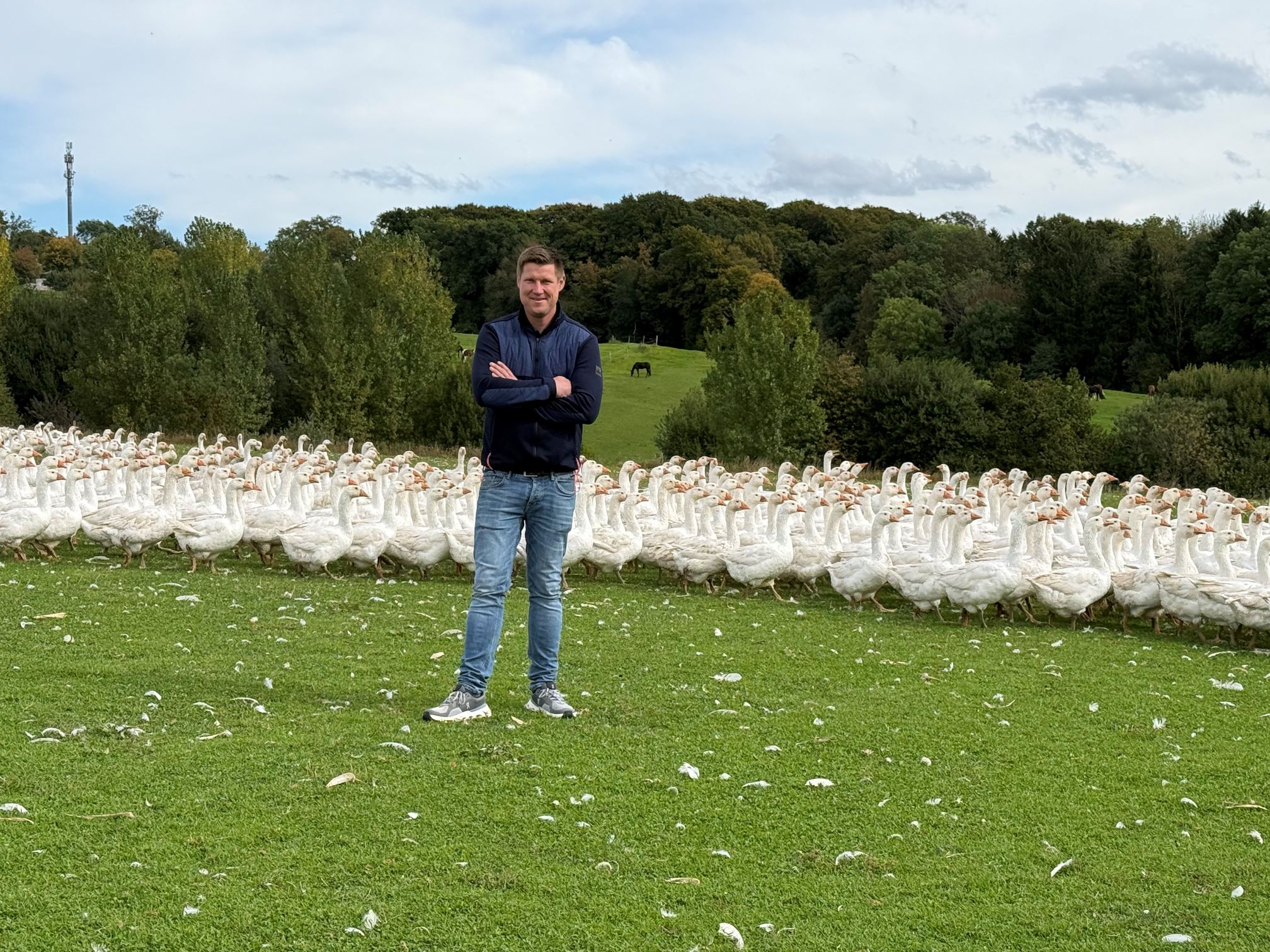
Andreas Trimborn in front of his 1500 geese, which have plenty of place, food and fresh air. They can also seek shelter in a maize field. The geese are an attraction for the visitors of the farm.
Photo: EU-FarmBook/ Aysegül Yasari

Finally, the journalists were invited to a meal by the Trimborns. Here they continued to discuss interesting stories.
Photo: EU-FarmBook/ Aysegül Yasari
Text: Katharina Seuser
Pictures: EU-FarmBook Jonathan Schmitt and Aysegül Yasari

